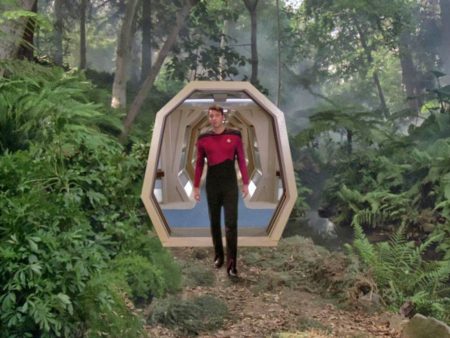July 29, 2019 – The original Star Trek series in the 1960s provided glimpses of different technologies that might be in our future, some much sooner, than later.
The communicator was a wireless device that bears a strong resemblance to the first flip phones.
In Star Trek the ship’s computer and crew interacted not just through keyboards but also by voice. Today we can converse with the digital world through Alexa, Google Home and Siri.
There were replicators that not only manufactured food, hot or cold, and the containers and cutlery with which to eat. We are seeing in the latest 3D printing technologies a future when the replicator will become a reality.
Some NASA scientists even believe that warp drive, a technology that alters a contained area of space around a starship to move it at speeds beyond light may be attainable.
And then there is the holodeck, a technology that first appeared in Star Trek’s Next Generation, in which crew members could immerse themselves and interact within a virtual reality without wearing goggles, or putting on a special sensor-laden suit.
How close are we to this type of immersive holodeck experience? In postings to this site in the past, I’ve written about Disney’s Holobench, and the University of Tokyo’s Haptoclone, but there is much more out there moving closer to turning the fiction of Star Trek into a reality.
Judge for yourself.
Uncompromising Immersion with SandboxVR
SandboxVR, a Hong Kong-based virtual reality gaming company, describes its technology as “bleeding edge” uncompromising immersion, as close to the holodeck as the world can get today. They use full-body motion capture technology in which you and others can experience VR together.
Steve Zhao, the founder, created his first VR game back in 2016. But in 2017 he decided to go for broke in building a VR interface as close to the holodeck experience as possible. SandboxVR opened its doors to the public that year but only a trickle of visitors came to experience immersive VR, that is, until a Facebook video about one visitor’s experience went viral. Zhao, in a piece he wrote for Medium, describes SandboxVR’s mission, “to create a reality where you can be what you want to be and go wherever you want to go.” Today a visitor to a SandboxVR can immerse themselves in three different virtual worlds: Curse of Davy Jones, where you can hunt for lost treasure, Amber Sky 2088, where you can experience a space elevator and deliver a package to Earth to save it from invaders, and Deadwood Mansion, where you get to fight zombies. Current locations include Hong Kong, Jakarta, Macau, San Francisco, Singapore, and Vancouver, with Austin, Chicago, Dallas, Los Angeles, New York, and San Diego, all coming soon.
Holo Representations of You That Can Speak Another Language
In pursuit of the Star Trek holodeck, Microsoft is developing what it calls a mixed reality capture studio with locations in San Francisco, London, and Redmond, Washington, that not only have technology in place to create life-like holograms but even can get the VR representation to speak in other languages simulating your voice. To do this Microsoft employs its HoloLens, mixed reality, and neural text-to-speech. The company has recently demonstrated this capability which you can watch here.
Bringing Immersive Reality to Any Location
And then there is Mixed Place, an Israeli company, that is developing mixed reality AR cloud infrastructure to stream location-specific experiences around the world. According to the company’s founder and CEO, Alon Melchner, the environment it is creating is midway between immersive VR and augmented reality (AR), superimposing 3D objects on the real world through a mobile phone, camera, VR/AR headsets, and VR contact lenses. Melchner’s invention allows virtual objects to blend into the real world and interact with it seamlessly.
In a recent article, he talks about what this could mean for retail: “We can create a virtual salesperson that knows when you’re getting closer to the store and can guide you in. Through your phone or smart glasses, you’ll see shoes personalized for you on the empty table. You can rotate them, change the colors and then make your order.”
Mixed Place technology doesn’t give you the ability to feel objects like the holodeck experience, but it creatives a powerful immersive blend of VR and AR. Imagine touring Pompeii and seeing what the city actually looked like before Vesuvius exploded. Or experiencing a game in a real physical location, not a studio, where you interact with virtual objects. As Melchner states, Mixed Place is “where content and the real environment become one.”
















